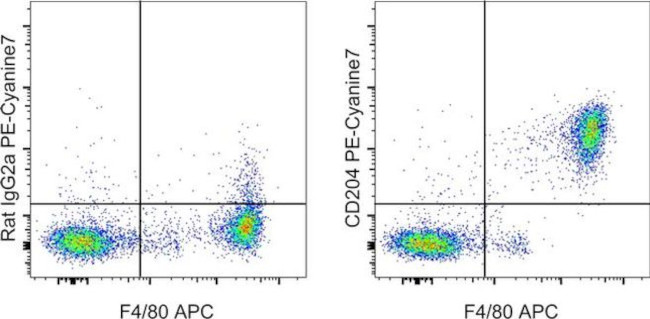Search Thermo Fisher Scientific
Invitrogen
CD204 Monoclonal Antibody (M204PA), PE-Cyanine7, eBioscience™
FIGURE: 1 / 1
CD204 Antibody (25-2046-82) in Flow

Product Details
25-2046-82
Species Reactivity
Host/Isotype
Recommended Isotype Control
Class
Type
Clone
Conjugate
Excitation/Emission Max
Form
Concentration
Purification
Storage buffer
Contains
Storage conditions
Shipping conditions
RRID
Product Specific Information
This M204PA antibody recognizes mouse CD204 also known as Macrophage Scavenger Receptor 1 (MSR 1), Scavenger Receptor A (SR-A) or SCARA1. CD204 belongs to the class A family of scavenger receptors that are primarily responsible for binding a wide variety of macromolecules and are involved in many aspects of macrophage activity. Other members of this family include: MARCO (SCARA2), CSR (SCARA3), SRCL (SCARA4) and SCARA5. All class A scavenger receptors are trans-membrane proteins with extracellular C-termini and homotrimeric structures. CD204 exists as 2 splice variants: the more ubiquitous full length isoform (type I) and a shorter isoform (type II) that lacks the C-terminal cysteine-rich domain. Both types are functional and bind modified LDL with similar affinity. In addition to lipid metabolism, CD204 plays an important role suppressing inflammation and macrophage activation. CD204 is considered one of the markers of M2 and Tumor-Associated Macrophages. Interestingly, this molecule is responsible for adherence of RAW264.7 cells to tissue culture-treated plastic in the absence of Ca and Mg cations.
This M204PA antibody binds to CD204 of multiple mouse strains, including C57Bl/6, Balb/c and Swiss-Webster (outbred). This antibody works on fixed cells and can be used to stain CD204 intracellularly. The M204PA antibody does not cross-react with human or rat. This antibody is not suitable for IHC staining.
This M204PA antibody has been tested by flow cytometric analysis of mouse resident peritoneal exudate cells. This can be used at less than or equal to 0.125 µg per test. A test is defined as the amount (µg) of antibody that will stain a cell sample in a final volume of 100 µL. Cell number should be determined empirically but can range from 10^5 to 10^8 cells/test. It is recommended that the antibody be carefully titrated for optimal performance in the assay of interest.
Filtration: 0.2 µm post-manufacturing filtered.
Target Information
CD204 gene encodes the class A macrophage scavenger receptors, which include three different types (1, 2, 3) generated by alternative splicing of this gene. These receptors or isoforms are macrophage-specific trimeric integral membrane glycoproteins and have been implicated in many macrophage-associated physiological and pathological processes including atherosclerosis, Alzheimer's disease, and host defense. The isoforms type 1 and type 2 are functional receptors and are able to mediate the endocytosis of modified low density lipoproteins (LDLs). The isoform type 3 does not internalize modified LDL (acetyl-LDL) despite having the domain shown to mediate this function in the types 1 and 2 isoforms. It has an altered intracellular processing and is trapped within the endoplasmic reticulum, making it unable to perform endocytosis. The isoform type 3 can inhibit the function of isoforms type 1 and type 2 when co-expressed, indicating a dominant negative effect and suggesting a mechanism for regulation of scavenger receptor activity in macrophages. Diseases associated with MSR1 include Barrett Esophagus and Prostate Cancer.
For Research Use Only. Not for use in diagnostic procedures. Not for resale without express authorization.
How to use the Panel Builder
Watch the video to learn how to use the Invitrogen Flow Cytometry Panel Builder to build your next flow cytometry panel in 5 easy steps.
References (0)
Bioinformatics
Protein Aliases: CD204; Macrophage acetylated LDL receptor I and II; Macrophage scavenger receptor types I and II; Scavenger receptor type A; SR-A; SR-AI/II
Gene Aliases: MRS-A; MSR; MSR-A; Msr1; Scara1; Scvr; SR-AI; SR-AII
UniProt ID: (Mouse) P30204
Entrez Gene ID: (Mouse) 20288

Performance Guarantee
If an Invitrogen™ antibody doesn't perform as described on our website or datasheet,we'll replace the product at no cost to you, or provide you with a credit for a future purchase.*
Learn more
We're here to help
Get expert recommendations for common problems or connect directly with an on staff expert for technical assistance related to applications, equipment and general product use.
Contact tech support

